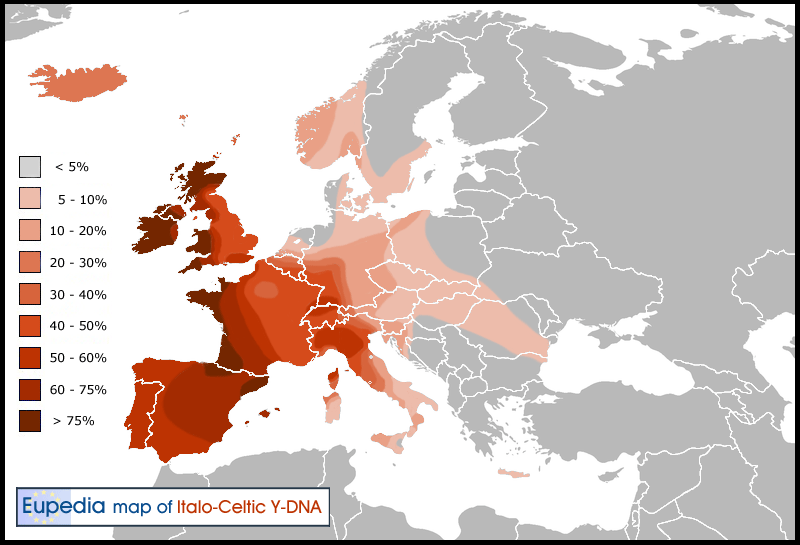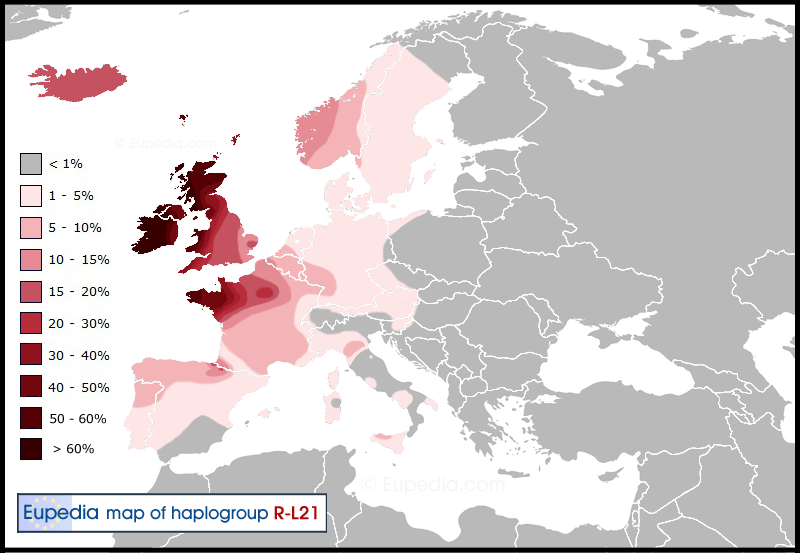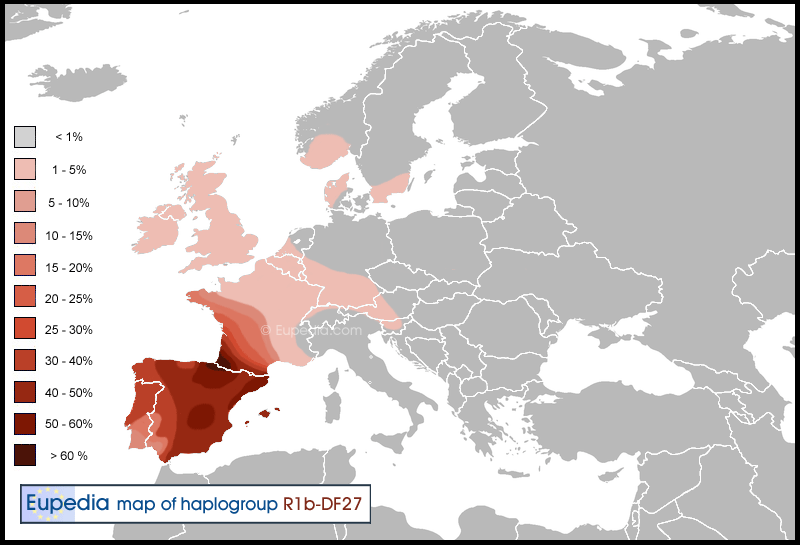Fire Haired
Regular Member
- Messages
- 689
- Reaction score
- 32
- Points
- 0
- Ethnic group
- Celto-Germanic, Latino(~6%)
- Y-DNA haplogroup
- R1b Df27(Spain)
- mtDNA haplogroup
- U5b2a2(Prussia)
for easier to read version click here
In the Geno 2.0 test my father got R1b1a2a1a P310/L11 which is the western European Germanic Italo Celtic? subclade of R1b(Spread of R1b1a2a1a L11 Germanic Italo Celts in western Europe). Geno 2.0 tests for Germanic? R1b1a2a1a1 S21, Italo Gaulic? R1b1a2a1a2b S28, Celtic? R1b1a2a1a2c L21 and later I learned we are not Germanic? R1b1a2a1a2e Df19. So the possibilities then are R1b1a2a1a L11*, R1b1a2a1a2 S116*, R1b1a2a1a2a Df27, and R1b1a2a1a2d L238. Since R1b L238 is very rare and from what I have read pretty much only found in Scandinavia since my direct male line goes back to the UK almost defintley Scotland or England that is really unlikely. R1b1a2a1a L11* is also very very rare I guess in Maciamo R1b L23(ht35) map were it shows R1b L23*. R1b L51*, R1b L11*, and R1b Z2103* in most of Britain and Ireland is 1-5% I guess makes it a possibility. I don't have any info on how popular R1b S116* is but I doubt anymore than R1b L11*.
When u put our STR's into I subclade and haplogroup predictor every time and I have done it over 10 times probably R1b North/South 2 is the most likely uselly around 50% probability with R1b S28 and R1b S21 second and third which I already know I don't belong to. I found out that R1b North/South is actulley under R1b Df27 I also heard actulley Df27 subclade Z196. If anything R1b1a2a1a2z Df27 seems most likely. But that is surprising since my male line goes back to the UK were the vast majority of R1b is Celtic R1b L21 and Germanic S21.
This also reminded me of how suprsing it is that deep deep subclades of R1b Df27 which are M153 and SRY2627 even though dominate around northern Iberia and southern France are found at 1-5% in the British isles and as far east as Germany and as far north as Scandinavia even though they should be young CeltIberian subclades.

But maps of main subclades of S116 besides Df27. So R1b S28 and L21 combine are only 15-25% and 20-30% that leaves out about 45% to other R1b1a2a1a2 S116 most likely mainly R1b Df27 with some R1b S116*. Overall in most of France you have about 10-20% left to most likely R1b Df17 and R1b S116*. In Highlands of Scotland, Wales, Ireland, and Cornwall(last areas in Europe with surviving Celtic languages) Italo Celtic R1b S116 is about >75%. But their main subclade R1b L21 according to Eupedia's maps is only about 50-60% while in Ireland and west coast of Scotland >60%.
 Then R1b S28 is about 1-5% in those areas. So that leaves about 10-20% to R1b Df27 and R1b S116*. So I don't think R1b Df27 is isolated to Iberia and is signature of Celts that migrated to Iberia like I did before. So I guess me having direct male line going back to British isles and having R1b Df27 is not extremely rare.
Then R1b S28 is about 1-5% in those areas. So that leaves about 10-20% to R1b Df27 and R1b S116*. So I don't think R1b Df27 is isolated to Iberia and is signature of Celts that migrated to Iberia like I did before. So I guess me having direct male line going back to British isles and having R1b Df27 is not extremely rare.
I think R1b L21 and R1b Df27 are signs of huge western expansion of proto Celts 3,500-4,500ybp during the bronze age. Before expansion of Urnfield culture then Hallstat culture about 3,500-2,500ybp in Celts France and west R1b S116 subclades would have only been R1b Df17 and R1b L21. R1b Df27 being the main in France and Iberia with minority R1b L21. While R1b L21 being dominate in British and Irish Celts with minority R1b Df27. Since now it seems R1b Df27 does not really break down into a specific area or Celtic language that hurts the theory of R1b1a2a1a L11 in western Europe being spread with Germanic and Italo Celtic languages.
Knowing the subclades and having age estimates of R1b Df27 throughout Europe mainly the British isles can give an idea if it came with R1b L21 3,500-4,500ybp or if it came from another migration. And of there are British and Irish R1b Df27 subclades and what about in France and Iberia.
In the Geno 2.0 test my father got R1b1a2a1a P310/L11 which is the western European Germanic Italo Celtic? subclade of R1b(Spread of R1b1a2a1a L11 Germanic Italo Celts in western Europe). Geno 2.0 tests for Germanic? R1b1a2a1a1 S21, Italo Gaulic? R1b1a2a1a2b S28, Celtic? R1b1a2a1a2c L21 and later I learned we are not Germanic? R1b1a2a1a2e Df19. So the possibilities then are R1b1a2a1a L11*, R1b1a2a1a2 S116*, R1b1a2a1a2a Df27, and R1b1a2a1a2d L238. Since R1b L238 is very rare and from what I have read pretty much only found in Scandinavia since my direct male line goes back to the UK almost defintley Scotland or England that is really unlikely. R1b1a2a1a L11* is also very very rare I guess in Maciamo R1b L23(ht35) map were it shows R1b L23*. R1b L51*, R1b L11*, and R1b Z2103* in most of Britain and Ireland is 1-5% I guess makes it a possibility. I don't have any info on how popular R1b S116* is but I doubt anymore than R1b L11*.
When u put our STR's into I subclade and haplogroup predictor every time and I have done it over 10 times probably R1b North/South 2 is the most likely uselly around 50% probability with R1b S28 and R1b S21 second and third which I already know I don't belong to. I found out that R1b North/South is actulley under R1b Df27 I also heard actulley Df27 subclade Z196. If anything R1b1a2a1a2z Df27 seems most likely. But that is surprising since my male line goes back to the UK were the vast majority of R1b is Celtic R1b L21 and Germanic S21.
This also reminded me of how suprsing it is that deep deep subclades of R1b Df27 which are M153 and SRY2627 even though dominate around northern Iberia and southern France are found at 1-5% in the British isles and as far east as Germany and as far north as Scandinavia even though they should be young CeltIberian subclades.
Eupedia map of R1b Df27(M153 and SRY2627) click to enlarge

Also in Eupedia's maps on the western coast of france you can see Italo Celtic R1b1a2a1a2 S116 is around 60-70% and >75%.


I think R1b L21 and R1b Df27 are signs of huge western expansion of proto Celts 3,500-4,500ybp during the bronze age. Before expansion of Urnfield culture then Hallstat culture about 3,500-2,500ybp in Celts France and west R1b S116 subclades would have only been R1b Df17 and R1b L21. R1b Df27 being the main in France and Iberia with minority R1b L21. While R1b L21 being dominate in British and Irish Celts with minority R1b Df27. Since now it seems R1b Df27 does not really break down into a specific area or Celtic language that hurts the theory of R1b1a2a1a L11 in western Europe being spread with Germanic and Italo Celtic languages.
Knowing the subclades and having age estimates of R1b Df27 throughout Europe mainly the British isles can give an idea if it came with R1b L21 3,500-4,500ybp or if it came from another migration. And of there are British and Irish R1b Df27 subclades and what about in France and Iberia.

